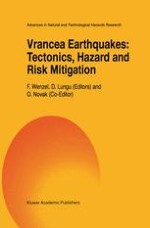1999 | OriginalPaper | Chapter
Modelling, for Microzonation Purposes, of the Seismic Ground Motion in Bucharest, Due to the Vrancea Earthquake of May 30, 1990
Authors : C. L. Moldoveanu, G. F. Panza
Published in: Vrancea Earthquakes: Tectonics, Hazard and Risk Mitigation
Publisher: Springer Netherlands
Included in: Professional Book Archive
Activate our intelligent search to find suitable subject content or patents.
Select sections of text to find matching patents with Artificial Intelligence. powered by
Select sections of text to find additional relevant content using AI-assisted search. powered by
The Vrancea seismoactive region, characterized by intermediate-depth earthquakes, is the quake source that has to be taken into account for microzonation purposes of Bucharest that could suffer serious damage also because of the severe local site effects. The strong seismic events originating in Vrancea have caused the most destructive damage experienced on the Romanian territory and may seriously affect vulnerable high risk constructions (such as nuclear power plants, chemical plants, large dams, pipelines etc.) located on a wide area, from Central Europe to Moscow.Realistic numerical simulation, describing the propagation of the seismic wavefield generated by a given quake in a complex geological structure, is a powerful tool, that may be efficiently used to estimate the ground motion for microzonation of the whole Bucharest area.The realistic modelling of ground motion is carried out by means of a sophisticated hybrid technique that combines modal summation (Panza, 1985; Vaccari et al, 1989; Florsch et al., 1991; Panza, 1993; Romanelli et al., 1996) and finite difference (Fäh 1991; Fäh and Panza, 1994; Fäh et al., 1994). The input data necessary for computations are the laterally variable anelastic structural model and the focal mechanism of the seismic source.The medium is modelled with a regional layered structure (bedrock structure), containing the seismic source and assumed to be representative of the path from the source to Bucharest, and a local structure, that is a NE20°SW oriented cross section, describing the local structure of Bucharest, along the studied path. The seismic source is described by a double-couple, buried in a layered medium, and corresponds to the focal mechanism of the May 30, 1990 Vrancea earthquake. The upper frequency limit considered in the computations is 1.0 Hz, and this allows us the modelling of seismic input appropriate for ten storeys and higher buildings.The simulated signals are satisfactorily compared with the available instrumental records from Magurele station (44.347°N, 26.030°E), and stability tests are performed with respect to the variation of focal mechanism, regional and local structure.
